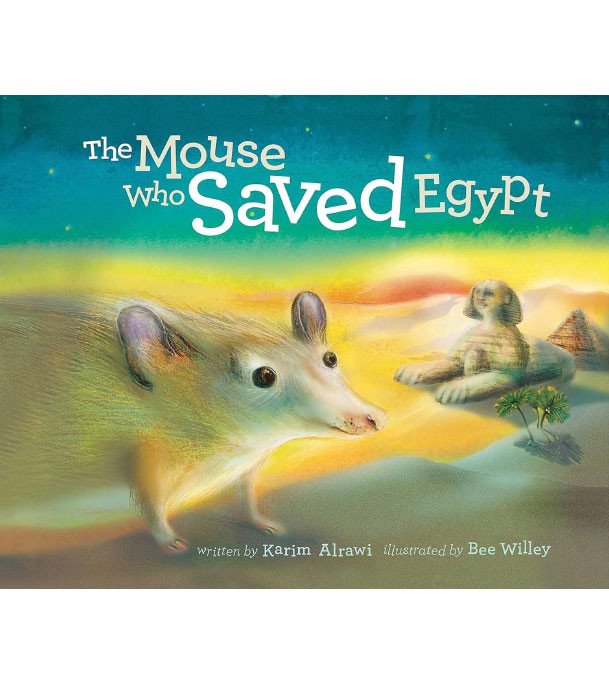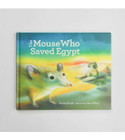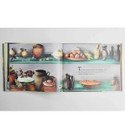
The Mouse Who Saved Egypt
By Crocodile Books
In his second work for children – following the successful 2000 picture book The Girl Who Lost Her Smile – Vancouver’s Karim Alrawi plucks a story from the rich history of his native Egypt and renders it appealing to a young and diverse audience.
The Mouse Who Saved Egypt is a wonderful retelling of an ancient Middle Eastern folktale with a straightforward plot: a prince takes the time to rescue a mouse trapped in a thorn bush; when the prince later becomes pharaoh, the mouse returns to save Egypt from attack.
Alrawi’s language is as timeless as the tale he tells. His extensive experience as a playwright is on full display; his third-person narrator recites the tale passionately but without embellishment, and when the rhyming prayer to the sun god Ra appears in the story, it is relayed with appropriate reverence and solemnity.
Illustrator Bee Willey’s generous spreads whisk readers away to the sun-bleached deserts and cool blue stones of ancient Egypt. Unlike the text, though, the illustrations have just a hint of the comic: a horse with a sheepish grin, men running amok with arms flung above their heads.
The message of the tale – faith in the reciprocity of good deeds – is presented in an elegant and functional manner. It assures little ones: do something good, and one day you’ll be rewarded for your kindness.
Editorial Reviews
Karim Alrawi plucks a story from the rich history of his native Egypt and renders it appealing to a young and diverse audience. The Mouse Who Saved Egypt is a wonderful retelling of an ancient Middle Eastern folk tale with a straightforward plot: a prince takes the time to rescue a mouse trapped in a thorn bush; when the prince later becomes pharaoh, the mouse returns to save Egypt from attack. Alrawi's language is as timeless as the tale he tells. His extensive experience as a playwright is on full display; his third person narrator recites the tale passionately but without embellishment, and when the rhyming prayer to the sun god Ra appears in the story, it is relayed with appropriate reverence and solemnity. Illustrator Bee Willey's generous spreads whisk readers away to the sun-bleached deserts and cool blue stones of ancient Egypt. Unlike the text, though, the illustrations have just a hint of the comic: a horse with a sheepish grin, men running amok with arms flung above their heads. The message of the tale faith in the reciprocity of good deeds is presented in an elegant and functional manner. It assures little ones: do something good, and one day you'll be rewarded for your kindness. ---Kristina Campbell, Quill & Quire
Children will be intrigued by the mystery and magic... The text is well supported by the rich two-page illustrations in mixed media. The images show the vastness and beauty of the Egyptian desert, as well as details of ancient culture and art, food, architecture and religion... Recommended. - --Resource Links
Alrawi s (The Girl Who Lost Her Smile) story carries the same do-unto-others message as Aesop s The Lion and the Mouse. Instead of a lion, a prince initially saves a mouse, disentangling it from a thornbush. True greatness is being kind, the mouse tells the prince as he runs off, and true kindness is never forgotten. Wiley (The Jesse Tree) creates a desert atmosphere by placing friendly, soulful-eyed characters against digitally manipulated backdrops of hieroglyphics, palms, and sand dunes, all lit with an eerie, gauzy glow. The prince is made pharaoh, and an army threatens the country; in repayment for the prince s good deed, the mouse persuades his fellow mice to sabotage the enemy army s equipment. The mice chewed through the leather of their bows, their saddles and the straps of their shields. In the morning, the mountain men could not tie their sandals, and their clothes fell off. The image of small creatures defeating the powerful is always gratifying, as is the book s thoughtful portrayal of Egyptian cultural themes. Ages 3 8. (Oct.) --Publishers Weekly, October 17 2011
Recommended... Egyptian-born Karim Alrawi narrates a captivating ancient Middle Eastern folk tale in an unadorned, yet engaging, manner. His voice is that of a storyteller, capturing the mystique and the grandeur of the land and its people. Bee Willey s double-paged digital artwork educates as well as entertains. Readers will be fascinated not only by the ancient Egyptian panorama, but also with the architecture, customs, clothing and communications of this venerable civilization. Look closely! The heroic mouse can be spotted on nearly every page. This delightful teaching tale exemplifies what a big difference a little bit of kindness can make. --Canadian Children s Book News
Award-winning writer and playwright, Karim Alrawi, brings a new renditions of Aesop s fable about the lion and the mouse. One day in the deserts of ancient Egypt a young prince rescues a tiny mouse trapped in thorns. The mouse promises to repay the act of kindness, but the young man is skeptical. Fortune favors the prince and he becomes pharaoh. When Egypt is threatened by a powerful enemy, he faces great danger. Just when he thinks that there is nothing to be done, the mouse he once helped returns to save the kingdom in a most unexpected way. With stunning and distinctive illustrations by Bee Willey, this teaching tale of kindness and it s rewards . . . shows how the smalled of creatures can also be the most heroic. --Foreword
"In his second work for children-following the successful 2000 picture book The Girl Who Lost Her Smile-Vancouver's Karim Alrawi plucks a story from the rich history of his native Egypt and renders it appealing to a young and diverse audience. The Mouse Who Saved Egypt is a wonderful retelling of an ancient Middle Eastern folk tale with a straightforward plot: a prince takes the time to rescue a mouse trapped in a thorn bush; when the prince later becomes pharaoh, the mouse returns to save Egypt from attack. Alrawi's language is as timeless as the tale he tells. His extensive experience as a playwright is on full display; his third-person narrator recites the tale passionately but without embellishment, and when the rhyming prayer to the sun god Ra appears in the story, it is relayed with appropriate reverence and solemnity. Illustrator Bee Willey's generous spreads whisk readers away to the sun-bleached deserts and cool blue stones of ancient Egypt. Unlike the text, though, the illustrations have just a hint of the comic: a horse with a sheepish grin, men running amok with arms flung above their heads. The message of the tale-faith in the reciprocity of good deeds-is presented in an elegant and functional manner. It assures little ones: do something good, and one day you'll be rewarded for your kindness." -- Kristina Campbell, Quill & Quire
The Mouse Who Saved Egypt receives Bee Willey's lovely drawings and tells of a young prince who rescues a tiny mouse. When Egypt is threatened by a powerful enemy, the mouse then saves the kingdom. This ancient Egypt folk story requires some reading skills but will provide a satisfying addition to any ethnic folk story collection.
$16.95
- SKU:
- CB-ARSTR-002318
- Gift wrapping:
- Options available
- Author:
- Karim Alrawi
- Publisher:
- Crocodile Books
- Illustrator:
- Bee Willey
- Format:
- Paperback
- Language:
- English
- Age Range:
- Pre-K - 2nd Level (2-5 Years)
In his second work for children – following the successful 2000 picture book The Girl Who Lost Her Smile – Vancouver’s Karim Alrawi plucks a story from the rich history of his native Egypt and renders it appealing to a young and diverse audience.
The Mouse Who Saved Egypt is a wonderful retelling of an ancient Middle Eastern folktale with a straightforward plot: a prince takes the time to rescue a mouse trapped in a thorn bush; when the prince later becomes pharaoh, the mouse returns to save Egypt from attack.
Alrawi’s language is as timeless as the tale he tells. His extensive experience as a playwright is on full display; his third-person narrator recites the tale passionately but without embellishment, and when the rhyming prayer to the sun god Ra appears in the story, it is relayed with appropriate reverence and solemnity.
Illustrator Bee Willey’s generous spreads whisk readers away to the sun-bleached deserts and cool blue stones of ancient Egypt. Unlike the text, though, the illustrations have just a hint of the comic: a horse with a sheepish grin, men running amok with arms flung above their heads.
The message of the tale – faith in the reciprocity of good deeds – is presented in an elegant and functional manner. It assures little ones: do something good, and one day you’ll be rewarded for your kindness.
Editorial Reviews
Karim Alrawi plucks a story from the rich history of his native Egypt and renders it appealing to a young and diverse audience. The Mouse Who Saved Egypt is a wonderful retelling of an ancient Middle Eastern folk tale with a straightforward plot: a prince takes the time to rescue a mouse trapped in a thorn bush; when the prince later becomes pharaoh, the mouse returns to save Egypt from attack. Alrawi's language is as timeless as the tale he tells. His extensive experience as a playwright is on full display; his third person narrator recites the tale passionately but without embellishment, and when the rhyming prayer to the sun god Ra appears in the story, it is relayed with appropriate reverence and solemnity. Illustrator Bee Willey's generous spreads whisk readers away to the sun-bleached deserts and cool blue stones of ancient Egypt. Unlike the text, though, the illustrations have just a hint of the comic: a horse with a sheepish grin, men running amok with arms flung above their heads. The message of the tale faith in the reciprocity of good deeds is presented in an elegant and functional manner. It assures little ones: do something good, and one day you'll be rewarded for your kindness. ---Kristina Campbell, Quill & Quire
Children will be intrigued by the mystery and magic... The text is well supported by the rich two-page illustrations in mixed media. The images show the vastness and beauty of the Egyptian desert, as well as details of ancient culture and art, food, architecture and religion... Recommended. - --Resource Links
Alrawi s (The Girl Who Lost Her Smile) story carries the same do-unto-others message as Aesop s The Lion and the Mouse. Instead of a lion, a prince initially saves a mouse, disentangling it from a thornbush. True greatness is being kind, the mouse tells the prince as he runs off, and true kindness is never forgotten. Wiley (The Jesse Tree) creates a desert atmosphere by placing friendly, soulful-eyed characters against digitally manipulated backdrops of hieroglyphics, palms, and sand dunes, all lit with an eerie, gauzy glow. The prince is made pharaoh, and an army threatens the country; in repayment for the prince s good deed, the mouse persuades his fellow mice to sabotage the enemy army s equipment. The mice chewed through the leather of their bows, their saddles and the straps of their shields. In the morning, the mountain men could not tie their sandals, and their clothes fell off. The image of small creatures defeating the powerful is always gratifying, as is the book s thoughtful portrayal of Egyptian cultural themes. Ages 3 8. (Oct.) --Publishers Weekly, October 17 2011
Recommended... Egyptian-born Karim Alrawi narrates a captivating ancient Middle Eastern folk tale in an unadorned, yet engaging, manner. His voice is that of a storyteller, capturing the mystique and the grandeur of the land and its people. Bee Willey s double-paged digital artwork educates as well as entertains. Readers will be fascinated not only by the ancient Egyptian panorama, but also with the architecture, customs, clothing and communications of this venerable civilization. Look closely! The heroic mouse can be spotted on nearly every page. This delightful teaching tale exemplifies what a big difference a little bit of kindness can make. --Canadian Children s Book News
Award-winning writer and playwright, Karim Alrawi, brings a new renditions of Aesop s fable about the lion and the mouse. One day in the deserts of ancient Egypt a young prince rescues a tiny mouse trapped in thorns. The mouse promises to repay the act of kindness, but the young man is skeptical. Fortune favors the prince and he becomes pharaoh. When Egypt is threatened by a powerful enemy, he faces great danger. Just when he thinks that there is nothing to be done, the mouse he once helped returns to save the kingdom in a most unexpected way. With stunning and distinctive illustrations by Bee Willey, this teaching tale of kindness and it s rewards . . . shows how the smalled of creatures can also be the most heroic. --Foreword
"In his second work for children-following the successful 2000 picture book The Girl Who Lost Her Smile-Vancouver's Karim Alrawi plucks a story from the rich history of his native Egypt and renders it appealing to a young and diverse audience. The Mouse Who Saved Egypt is a wonderful retelling of an ancient Middle Eastern folk tale with a straightforward plot: a prince takes the time to rescue a mouse trapped in a thorn bush; when the prince later becomes pharaoh, the mouse returns to save Egypt from attack. Alrawi's language is as timeless as the tale he tells. His extensive experience as a playwright is on full display; his third-person narrator recites the tale passionately but without embellishment, and when the rhyming prayer to the sun god Ra appears in the story, it is relayed with appropriate reverence and solemnity. Illustrator Bee Willey's generous spreads whisk readers away to the sun-bleached deserts and cool blue stones of ancient Egypt. Unlike the text, though, the illustrations have just a hint of the comic: a horse with a sheepish grin, men running amok with arms flung above their heads. The message of the tale-faith in the reciprocity of good deeds-is presented in an elegant and functional manner. It assures little ones: do something good, and one day you'll be rewarded for your kindness." -- Kristina Campbell, Quill & Quire
The Mouse Who Saved Egypt receives Bee Willey's lovely drawings and tells of a young prince who rescues a tiny mouse. When Egypt is threatened by a powerful enemy, the mouse then saves the kingdom. This ancient Egypt folk story requires some reading skills but will provide a satisfying addition to any ethnic folk story collection.












